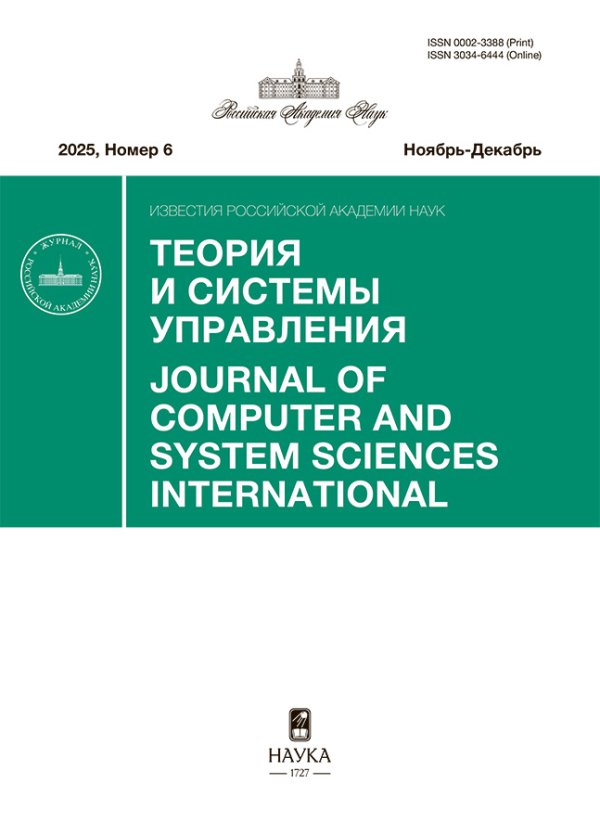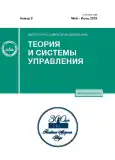Optimization of the Risk Functional to Control the Composition and Structure of a Heterogenous Grouping of Detection Sensors in Three-Dimensional Space
- Authors: Dyukov V.A.1, Kazantsev A.M.2, Makushev I.Y.3, Putilin M.S.1, Timoshenko A.V.4
-
Affiliations:
- National Research University of Electronic Technology (MIET), 124498, Moscow, Russia
- Mints Radiotechnical Institute, 127083, Moscow, Russia
- PAO MAC Vympel, 125319, Moscow, Russia
- Moscow Aviation Institute (National Research University), 121552, Moscow, Russia
- Issue: No 3 (2023)
- Pages: 57-75
- Section: SYSTEM ANALYSIS AND OPERATIONS RESEARCH
- URL: https://journals.rcsi.science/0002-3388/article/view/136873
- DOI: https://doi.org/10.31857/S0002338823020075
- EDN: https://elibrary.ru/JEZOLY
- ID: 136873
Cite item
Full Text
Abstract
The steady growth in the scale and dynamics of the use of aerial weapons in the course of various conflicts necessitates the formulation and solution of the problems of building realistic systems to detect them. It should be noted that the priorities in the development of detection sensors is changing from solving problems to improve their characteristics to optimization and adaptability in controlling them. As an object, a heterogeneous grouping of sensors, which solves the problem of detecting a moving airborne object, is considered. The subject is the methodology for constructing control models for heterogeneous detection sensors. Based on the analysis of the antagonistic interaction of a heterogeneous grouping and airborne objects, as well as the processes of their functioning, a geometric approach to solve the problem of detecting a moving object (MO) is proposed, which uses an adapted and improved risk functional as one of the possible indicators for the further synthesis of the control algorithms. The practical effectiveness of the application of this functionality is substantiated and compared with other performance indicators through simulation modeling.
About the authors
V. A. Dyukov
National Research University of Electronic Technology (MIET), 124498, Moscow, Russia
Email: kazantsev.andrei@gmail.com
Россия, Москва
A. M. Kazantsev
Mints Radiotechnical Institute, 127083, Moscow, Russia
Email: kazantsev.andrei@gmail.com
Россия, Москва
I. Yu. Makushev
PAO MAC Vympel, 125319, Moscow, Russia
Email: kazantsev.andrei@gmail.com
Россия, Москва
M. S. Putilin
National Research University of Electronic Technology (MIET), 124498, Moscow, Russia
Email: kazantsev.andrei@gmail.com
Россия, Москва
A. V. Timoshenko
Moscow Aviation Institute (National Research University), 121552, Moscow, Russia
Author for correspondence.
Email: kazantsev.andrei@gmail.com
Россия, Москва
References
- Галяев А.А., Маслов Е.П., Рубинович Е.Я. Об одной задаче управления движением объекта в конфликтной среде // Изв. РАН. ТиСУ. 2009. № 3. С. 134–140.
- Галяев А.А., Маслов Е.П. Оптимизация закона уклонения подвижного объекта от обнаружения при наличии ограничений // АиТ. 2012. № 6. С. 73–88.
- Абрамянц Т.Г., Маслов Е.П., Яхно В.П. Уклонение подвижного объекта от обнаружения группой наблюдателей // Проблемы управления. 2010. № 5. С. 73–79.
- Zabarankin M., Uryasev S., Pardalos P. Optimal Risk Path Algorithms // Cooperative Control and Optimization. Applied Optimization. 2002. V. 66. P. 273–298.
- Петров М.Ю. Построение маршрута полета летательного аппарата на малых высотах // Изв. РАН. ТиСУ. 2019. № 3. С. 140–146.
- Шайкин М.Е. О статистическом функционале риска в задаче управления движением объекта в конфликтной среде // Изв. РАН. ТиСУ. 2011. № 1. С. 22–31.
- Dogan A., Ugur Z. Unmanned Aerial Vehicle Dynamic-Target Pursuit by Using Probabilistic Threat Exposure Map // AIIA Guidance, Dynamics and Control. 2006. V. 29. № 4. P. 944–954.
- Воронин А.Н., Зиатдинов Ю.К., Пермяков А.Ю., Варламов И.Д. Синтез компромиссно-оптимальных траекторий мобильных объектов в конфликтной среде // Сучасні інформаційні технології у сфері безпеки та оборони. 2015. № 1 (22). С. 40–49.
- Kumar G.N., Dadarya S., Verandani A., Sarkar A.K., Talole S.E. Cruise Missile Mission Planning Using Genetic Algorithm // Proc. Intern. Conf. on Modern Research in Aerospace Engineering. Noida, NCR-Delhi, 2018. P. 353–362.
- Zabarankin M., Uryasev S., Murphey R. Aircraft Routing Under the Risk of Detection // Naval Research Logistics. 2006. V. 53. P. 728–747.
- Zhang Z., Wu J., Dai J., He C. A Novel Real-Time Penetration Path Planning Algorithm for Stealth UAV in 3D Complex Dynamic Environment // IEEE Access. 2020. V. 8. P. 122757–122771.
- Dijkstra E. A Note of Two Problems in Connection with Graphs // Numerische Mathematik. 1959. V. 1. P. 269–271.
- Jong-Jin S., Hyochoong B. UAV Path Planning under Dynamic Threats Using an Improved PSO Algorithm // Intern. Aerospace Engineering. 2020. V. 10. P. 1–17.
- Miller B., Stepanyan K., Miller A., Andreev M. 3D Path Planning in a Threat Environment // Proc. IEEE Conf. on Decision and Control and European Control Conf. Orlando, FL, USA, 2011. P. 6864–6869.
- Ежов Г.В. Алгоритмы нахождения пути, их сравнение и визуализация на базе движка Unity // Молодой ученый. 2020. № 50 (340). С. 15–24.
- Hart P.E., Nilsson N.J., Raphael B.A. Formal Basis for the Heuristic Determination of Minimum Cost Paths // IEEE Transactions on Systems Science and Cybernetics SSC4. 1968. V. 4. № 2. P. 100–107.
- Евдокименков В.Н., Красильщиков М.Н., Ляпин Н.А. Гарантирующее управление траекторией̆ беспилотного летательного аппарата при сближении с маневрирующей воздушной целью // Изв. РАН. ТиСУ. 2018. № 5. С. 40–53. https://doi.org/10.31857/S000233880002851-5
- Евдокименков В.Н., Красильщиков М.Н., Себряков Г.Г. Распределенная интеллектуальная система управления группой беспилотных летательных аппаратов: архитектура и программно-математическое обеспечение // Системы управления, связи и безопасности. 2019. № 3. С. 1–13. https://doi.org/10.24411/2410-9916-2019-10301
- Справочник офицера воздушно-космической обороны / Под общ. ред. С.К. Бурмистрова. Тверь: BA ВКО, 2006. 564 с.
- Тяпкин В.Н., Фомин А.Н., Гарин Е.Н. и др. Основы построения радиолокационных станций радиотехнических войск: учебник / Под общ. ред. В.Н. Тяпкина. Красноярск: Сибирск. федер. ун-т, 2016. 536 с.
- Пантенков Д.Г., Гусаков Н.В. Компьютерное моделирование активной фазированной антенной решетки// Космическая техника и технологии. 2013. № 1. С. 34–39.
- https://earthexplorer.usgs.gov/
- Valavanis K.P., Vachtsevanos G.J. Handbook of Unmanned Aerial Vehicles. Dordrecht: Springer, 2015.
Supplementary files























